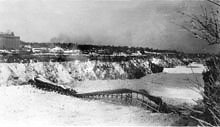Upper Steel Arch Bridge Honeymoon Bridge Fallsview Bridge | |
|---|---|
 The Upper Steel Arch Bridge at Niagara Falls | |
| Coordinates | 43°5′13.2″N79°4′15.6″W / 43.087000°N 79.071000°W |
| Crossed | Niagara River |
| Preceded by | Niagara Clifton Bridge |
| Followed by | Rainbow Bridge |
| Characteristics | |
| Design | Steel Arch Bridge |
| Total length | 1,240 ft (378 m) [1] |
| Longest span | 840 ft (256 m) [2] |
| History | |
| Construction end | 1897 |
| Opened | 1898 |
| Collapsed | January 1938 |
| Location | |
 | |
The Upper Steel Arch Bridge, also known as the Honeymoon Bridge or Fallsview Bridge (less frequentlyFalls View Bridge), was an international bridge which crossed the Niagara River, connecting Niagara Falls, Ontario, Canada, with Niagara Falls, New York, United States. It was located about 500 feet (150 m) upriver of the present-day Rainbow Bridge. It collapsed in 1938.





